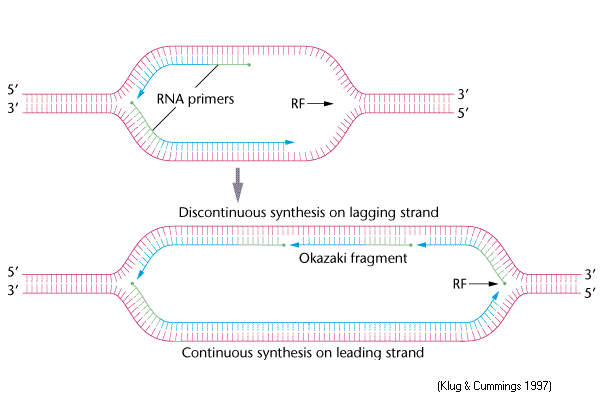
Schematic
presentation of Continuous &
Discontinuous DNA synthesis
Extension of RNA
primers occurs by addition of nucleotides to the 3'
ends of both DNA strands simultaneously, such that
growth occurs on both in the 5' 3' direction only.
In this schematic, the replication fork (RF)
is shown as opening to the right. On the lower leading
strand, synthesis is continuous because extension of a
single RNA primer occurs without
interruption into the replication fork as it continues to open
to the
right. On
the upper lagging strand, synthesis is discontinuous,
since
new RNA primers must be added as
opening
of the replication fork continues to expose new template. This
produces a series of disconnected Okazaki fragments.
3' direction only.
In this schematic, the replication fork (RF)
is shown as opening to the right. On the lower leading
strand, synthesis is continuous because extension of a
single RNA primer occurs without
interruption into the replication fork as it continues to open
to the
right. On
the upper lagging strand, synthesis is discontinuous,
since
new RNA primers must be added as
opening
of the replication fork continues to expose new template. This
produces a series of disconnected Okazaki fragments.
In this diagram, note that 'left'
and 'right', and 'top' and 'bottom' are
arbitrary: the molecule could be flipped vertically or
horizontally. Only the 5'-3' orientation of the two
strands is fixed. Note also that the schematic shows extension
on either strand occuring as two separate processes, separated
from the RF. In fact, DNA synthesis occurs as
a single process involving a dimeric polymerase molecule
situated at the RF.
All text
material © 2014 by Steven M.
Carr